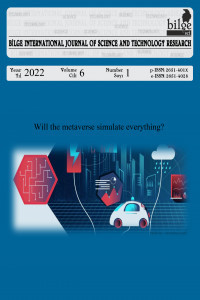Challenges in Lecturing Sport and Exercise Technology using Online Platforms during the COVID-19 Pandemic
Challenges in Lecturing Sport and Exercise Technology using Online Platforms during the COVID-19 Pandemic
COVID-19, Sport and Exercise Technology Accesibility, Adjustments, Attitudes,
___
- Algahtani, A (2011) Evaluating the effectiveness of the e-learning experience in some universities in Saudi Arabia from male students' perceptions. Durham: Durham University.
- Akcil, U. & Bastas, M. (2021). Examination of University Students Attitudes towards E-Leanring during the COVID-19 Pandemic Process and the Relationship of Digital Citizenship. Contemporary Educational Technology, 13(1); ep291, https://doi.org/10.30935/cedtech/9341.
- Anderson, M., & Kumar, M. (2019, May 7). Digital divide persists even as lower-income Americans make gains in tech adoption. Pew Research Center. Retrieved from https:// www.pewresearch.org/fact-tank/2019/05/07/digital-divide-persists-even-as-lower-incomeamericans-make-gains-in-tech-adoption.
- Asch, S. (2020, April 5). Vermont colleges loosen grading as Covid-19 crisis raises equity concerns. VTDIGGER. Retrieved from https:// https://vtdigger.org/2020/04/05/vermont-colleges-loosen-grading-as-covid-19-crisis-raises-equity-concerns/
- Ashour, S., El-Refae, G. A., & Zaitoun, E. A. (2021). Post-pandemic higher education: Perspectives from university leaders and educational experts in the United Arab Emirates. Higher Education for the Future. https://doi.org/10.1177/23476311211007261.
- Bali, S., & Liu, M. C. (2018, July 21). Students perceptions toward online learning and face-to-face learning courses. Journal of Physics: Conference Series. 1108, 012094. https://doi.org/10.1088/1742-6596/1108/1/012094. Bowyer, J. and Chambers, L. (2017). Evaluating blended learning: bringing the elements together. Research Matters: A Cambridge Assessment Publication, available at: www.cambridgeassessment.org.
- Chandwani, S., Singh, N., & Singh, G. (2021, April). Attitude of Faculty Towards Online Teaching and Learning in Relation to Certain Variables: A Study During Coronavirus (COVID-19) Pandemic in India. Library Philosophy and Practice (e-journal). 5330, 1–13. Retrieved from https://digitalcommons.unl.edu/libphilprac/5330.
- Edwards, A. & McKinnell, S. (2007). Moving from dependence to independence: The application of e-learning in higher education. Learning, Teaching and Assessing in Higher Education: Developing Reflective Practice: 68.
- Emmanuel, G. (2020, June 2). Kerala's experiment with virtual classes: Upset over not having smartphone, Class 10 girl commits suicide. Mumbai Mirror. Retrieved from https://mumbaimirror.indiatimes.com/news/india/keralas-experiment-with-virtual-classesupset-over-not-having-smartphone-class-10-girl-commitssuicide/articleshow/76151031.cms .
- Godber, K. A., & Atkins, D. R. (2021, July). COVID-19 Impacts on Teaching and Learning: A Collaborative Autoethnography by Two Higher Education Lecturers. Frontiers in Education. 6, 647524. https://doi.org/10.3389/feduc.2021.647524.
- Hubackova, S. & Semradova, I. (2016). Evaluation of blended learning. Procedia – Social and Behavioral Sciences, 217, 551-557. Available at: https://doi.org/10.1016/j.
- Ivemark, B. & Ambrose, A. (2021, May 26). Habitus Adaption and First-Generation University Students’ Adjustment to Higher Education: A Life course Perspective. Sociology of Education. 94(3), 191–207. https://doi.org/10.1177/00380407211017060.
- Jowsey, T., Foster, G., Cooper-Ioelu, P. & Jacobs, S. (2020). Blended learning via distance in pre-registration nursing education: a scoping review”, Nurse Education in Practice, 44, 102775.
- Lee, J., March, L., & Peters, R. (2015, November). Faculty training and approach to online education: Is there a connection? American University: Center for Teaching, Research & Learning. Retrieved from https://edspace.american.edu/online/wp-content/uploads/sites/504/2016/03/FacultyTrainingAnd ApproachToOnlineEducation.pdf
- Murgatrotd, S. (2020, March). COVID-19 and Online learning, Alberta, Canada. https://doi.org/10.13140/RG.2.2.31132.85120.
- Nordmann, E., Horlin, C., Hutchison, J., Murray, J.-A., Robson, L., Seery, M. K., & MacKay, J. R. (2020). Ten simple rules for supporting a temporary online pivot in higher education. PLoS Computational Biology, 16(10). https://doi.org/10.1371/journal.pcbi.1008242.
- Rodríguez-Triana, M. J., Prieto, L. P., Ley, T., de Jong, T., & Gillet, D. (2020). Social practices in teacher knowledge creation and innovation adoption: A large-scale study in an online instructional design community for inquiry learning. International Journal of Computer-Supported Collaborative Learning, 15(4), 445-467. https://doi.org/10.1007/s11412-020-09331-5.
- Woo, K., Gosper, M., McNeill, M., Preston, G., Green, D., & Phillips, R. (2008). Web-based lecture technologies: Blurring the boundaries between face-to-face and distance learning. Research in Learning Technology. 16(2), 81–93. https://doi.org/10.1080/09687760802315895
- ISSN: 2651-401X
- Yayın Aralığı: Yılda 2 Sayı
- Başlangıç: 2017
- Yayıncı: Kutbilge Akademisyenler Derneği
Antibacterial activity of the vapor phase of Thymus mastichina essential oil
Lucia GALOVİČOVÁ, Natália ČMİKOVÁ, Veronika VALKOVÁ, Miroslava KAČÁNİOVÁ
The Effects of the Traditional Data Augmentation Techniques on Long Bone Fracture Detection
Gülnur Begüm CANGÖZ, Selda GÜNEY
Evaluation of the Warehouse Location Alternatives for Possible Great Istanbul Earthquake
Asli Gul YALCİNDAG, Mehtap DURSUN, Nazlı GOKER
Hayati MAMUR, Çiğdem AKYILDIZ, Mehmet Ali ÜSTÜNER
Examination of Player Positions by Cluster Analysis
Okan DAĞ, Asım Sinan YÜKSEL, Şerafettin ATMACA
Characterization Of Soil For Road Shoulders Mixed With Reclaimed Asphalt Pavement Waste
Saber Shah SABERİ, Azman MOHAMED
Chantell GOUWS, Gerrit Jan BREUKELMAN, Lourens MİLLARD
Characteristics Of Some Warm Climate Grass Plants Commonly Used In Green Field Plant
Mustafa TOSUN, Sait Dündar SOFUOĞLU
Antifungal Efficacy of Mint Essential Oil Against Penicillium spp. Inoculated on Carrots
Veronika VALKOVÁ, Hana ĎÚRANOVÁ, Lucia GALOVİČOVÁ, Nenad VUKOVİC, Milena VUKİC, Miroslava KAČÁNİOVÁ
